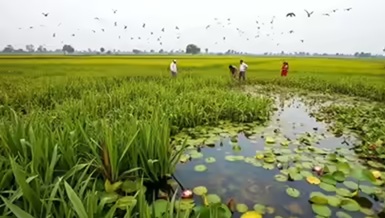Wetlands are areas that are permanently or seasonally saturated with water. They include marshes, peatlands, floodplains, swamps, lakes, riverine and coastal areas, as well as saline or freshwater zones and coastal waters up to 6 meters deep. Although wetlands cover only about 6% of the Earth’s surface, they provide habitat for 40% of global biodiversity and are often called the natural “ecological kidneys” of the planet.

Current Status in India
- India has more than 7 lakh wetlands.
- Total area is approximately 16 million hectares, around 4.86% of the country’s geographical area.
- According to Wetlands International South Asia, 2 out of every 5 wetlands have been lost over the past three decades.
- Tamil Nadu has the highest number of Ramsar sites, followed by Uttar Pradesh.
Importance of Wetlands
(A) Ecological and Environmental Importance
- Carbon sink: Absorb carbon and help mitigate climate change.
- Natural disaster mitigation: Provide protection against floods, coastal erosion, and storm surges.
- Water purification: Act as natural filters by trapping pollutants in sediments and vegetation.
- Biodiversity hotspot: Support diverse species of birds, fish, amphibians, and plants.
(B) Socio-Economic Importance
- Provide livelihoods through fisheries, agriculture, handicrafts, and tourism.
- Serve as centers of cultural, spiritual, and recreational activities.
Major Causes of Wetland Degradation
- Encroachment and land-use change: Urban expansion, illegal construction, and infrastructure projects.
- Excessive water extraction and salinization: Groundwater over-extraction and saltwater intrusion.
- Pollution: Discharge of urban/industrial waste, agricultural runoff, and untreated sewage.
- Invasive species: e.g., water hyacinth and Salvinia, which damage water quality and biodiversity.
- Unsustainable exploitation: Overuse of fish, timber, sand, and water resources.
- Unregulated tourism: Expansion of tourism infrastructure without proper management.
- Climate change: Sea-level rise, droughts, and harmful algal blooms (HABs).
Government Initiatives in India
1. Policies and Regulations
- Wetlands (Conservation and Management) Rules, 2017: Notifications, management plans, and monitoring committees at state and central levels.
- National Plan for Conservation of Aquatic Ecosystems (NPCA): Centrally sponsored scheme for the protection of lakes and wetlands.
- Central Wetland Conservation and Management (cWCM) Programme: Provides scientific guidance, capacity building, and policy support.
2. Water Conservation Missions
- National Mission for Clean Ganga (NMCG): Focuses on restoration of wetlands associated with the Ganga river basin.
3. International Cooperation
- Ramsar Convention (since 1982): India currently has 94 Ramsar sites (as of 2025).
4. Other Initiatives
- Blue Flag Beach Certification: Implemented at 12 Indian beaches.
- AMRUT Heritage Initiative: Community-based wetland conservation models.
Challenges
- Lack of scientific data and standard monitoring protocols.
- Poor coordination among different government departments.
- Limited community participation.
- Weak regulation of land-use changes.
- Environmental conservation often sidelined due to political/economic priorities.
Way Forward
- Integrated and science-based management
- Integrated Wetland Management Plans (IWMPs): Address hydrology, biodiversity, land use, and livelihoods together.
- Ecosystem-based management
- Establish buffer zones, restore native vegetation, and build coastal protection structures.
- Community participation
- Involve self-help groups, local forest committees, and eco-tourism committees.
- Expand models like the AMRUT Heritage Initiative.
- Pollution control
- Treat urban sewage and implement strict pollution standards with penalties for violations.
- Monitoring and data systems
- GIS-based wetland inventories, health cards, and ecosystem health assessment protocols.
- Climate adaptation strategies
- Restore coral reef areas, coastal wetlands, and mangroves to enhance resilience.
Conclusion
Wetlands form the foundation of India’s ecological and economic security. Their degradation poses serious threats to biodiversity, livelihoods, water security, and climate stability. Successful conservation requires strengthening legal frameworks, promoting community-based models, and using scientific monitoring to safeguard wetlands as valuable natural capital.



